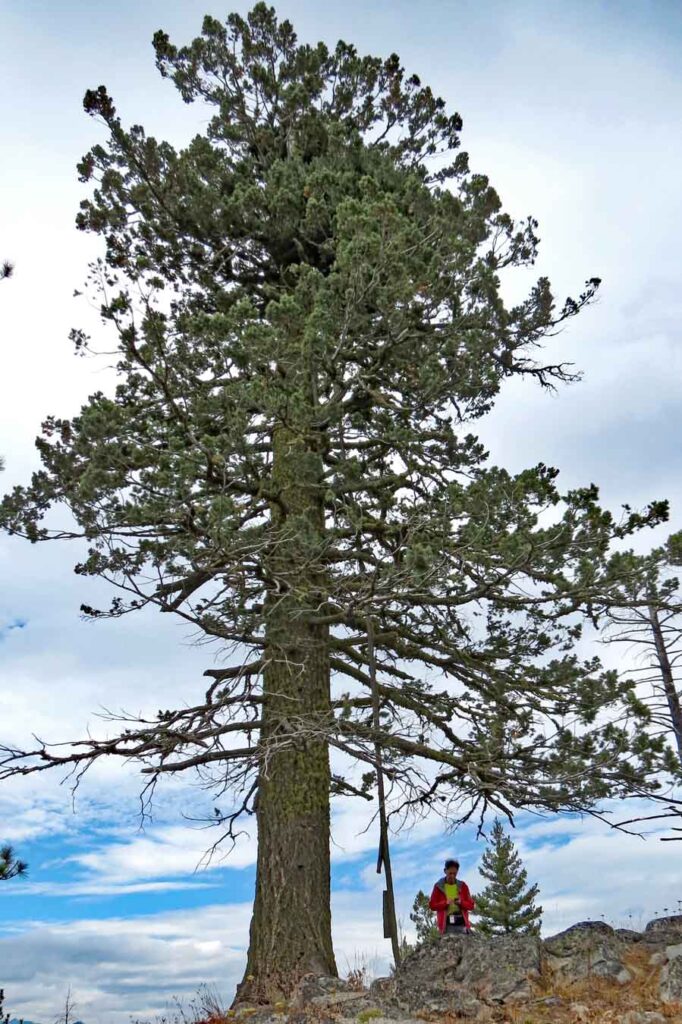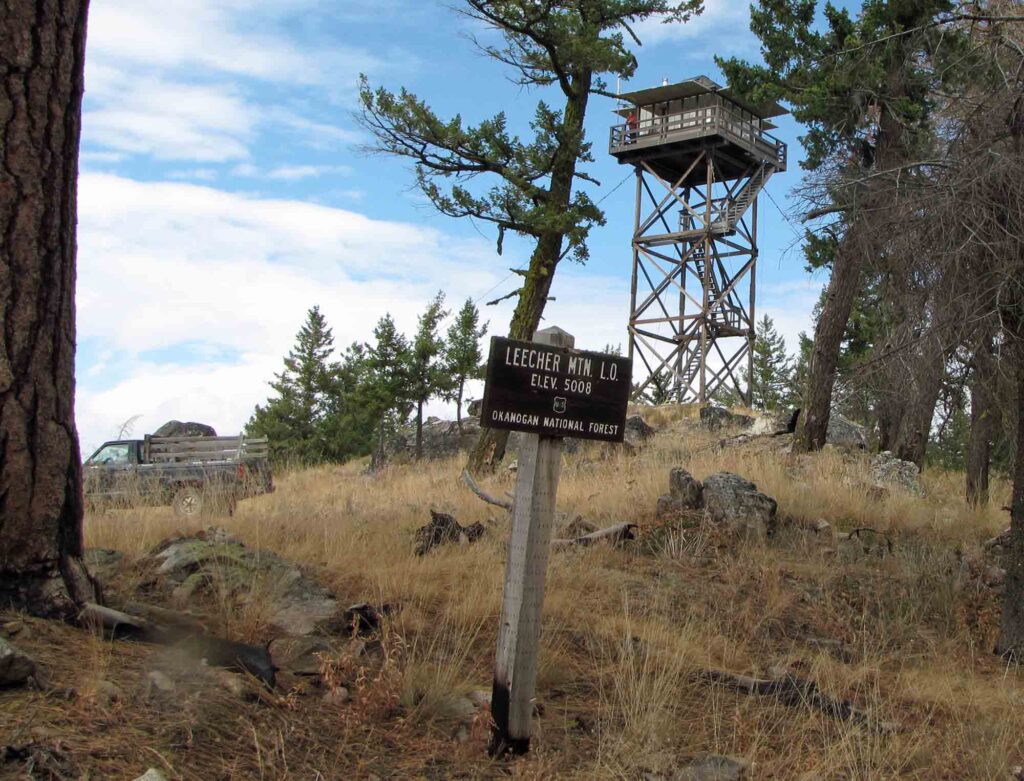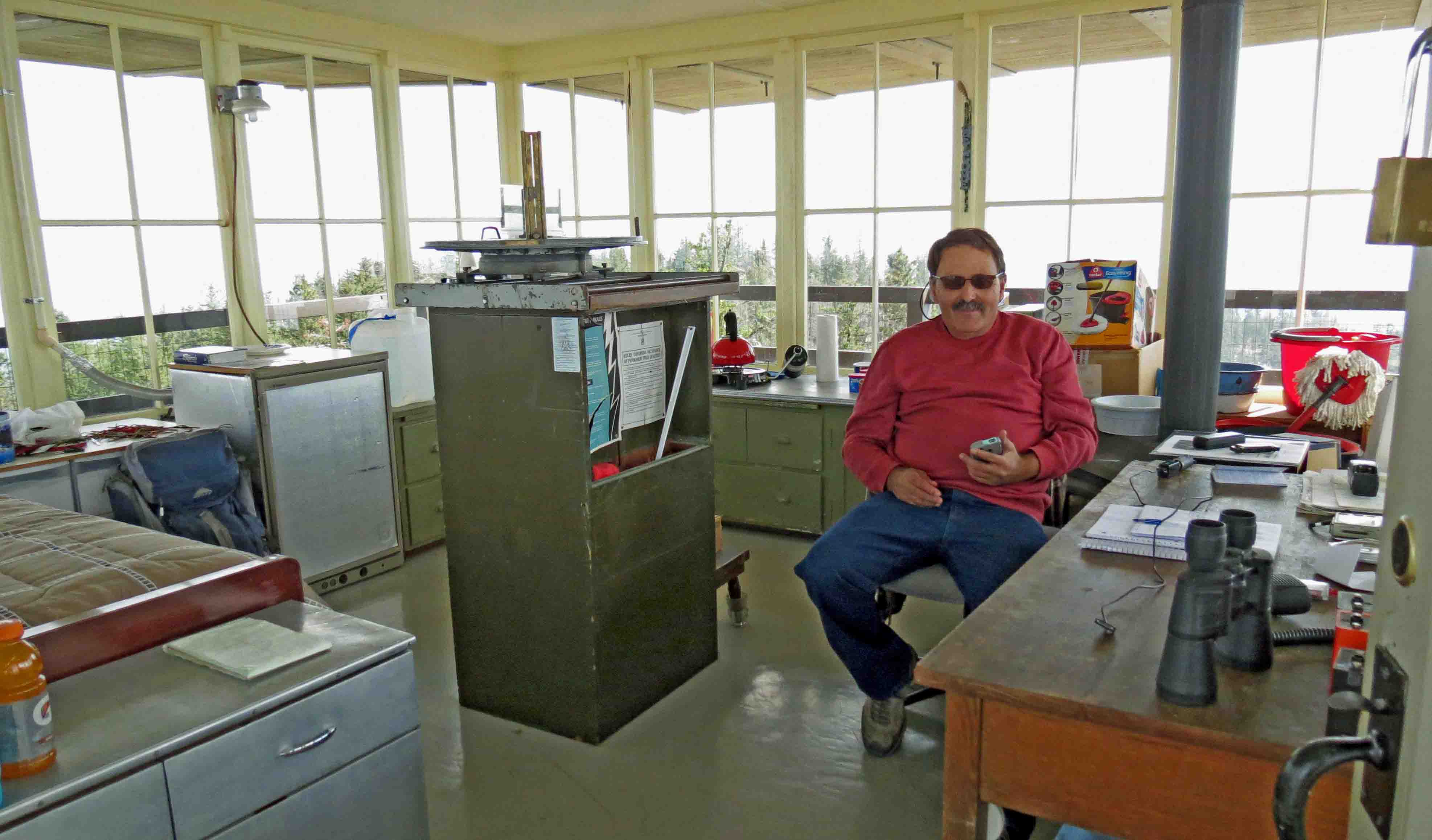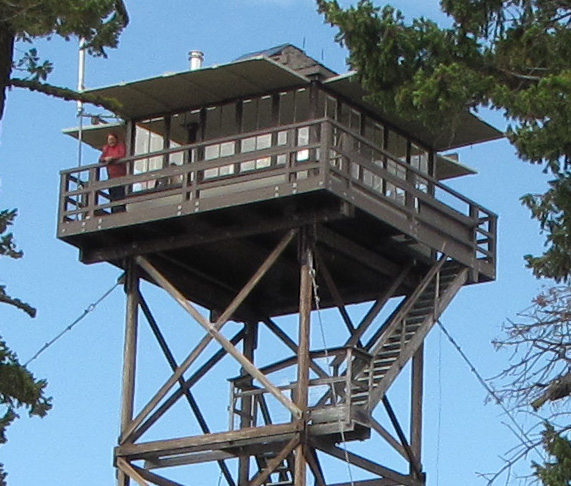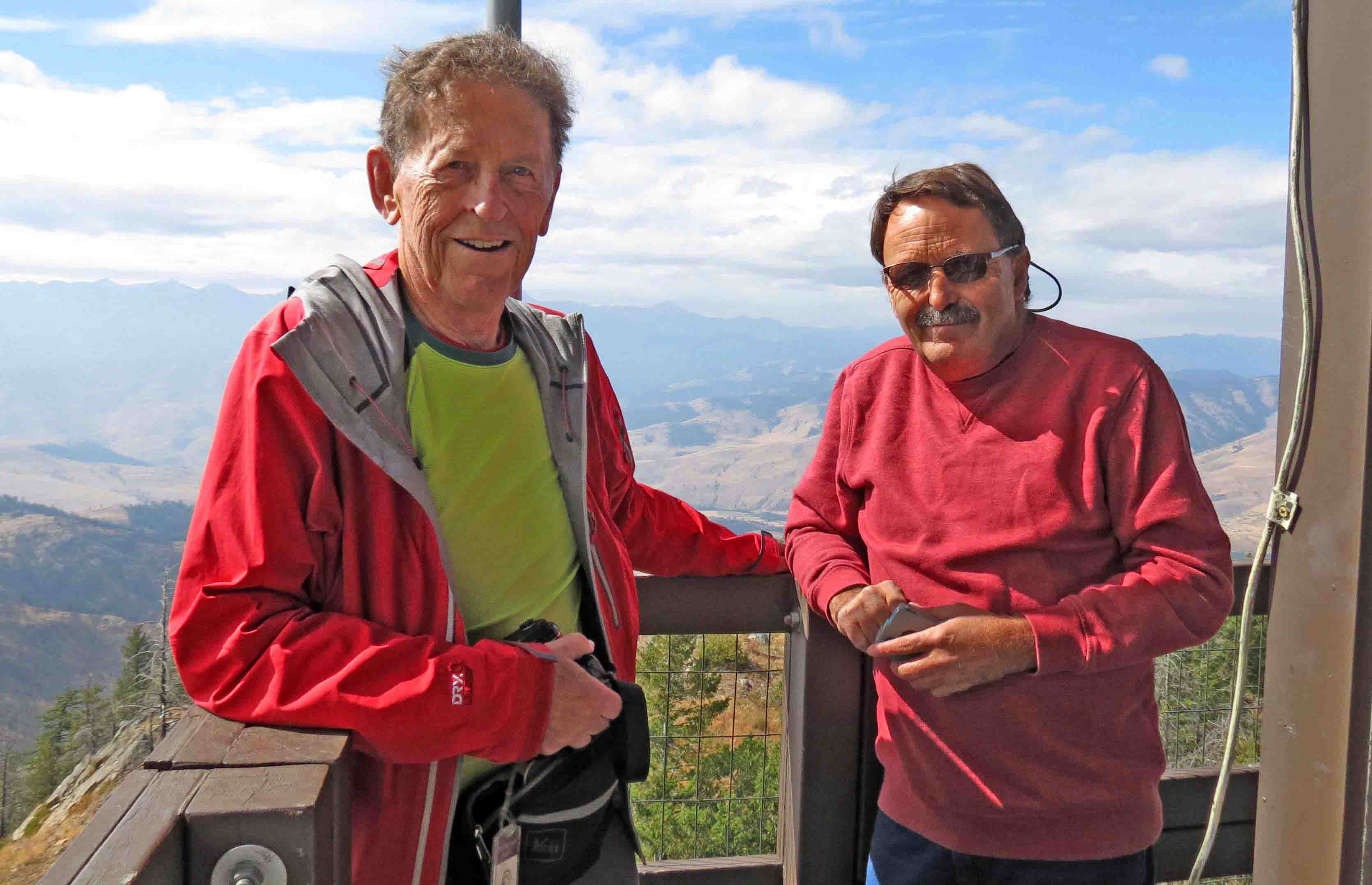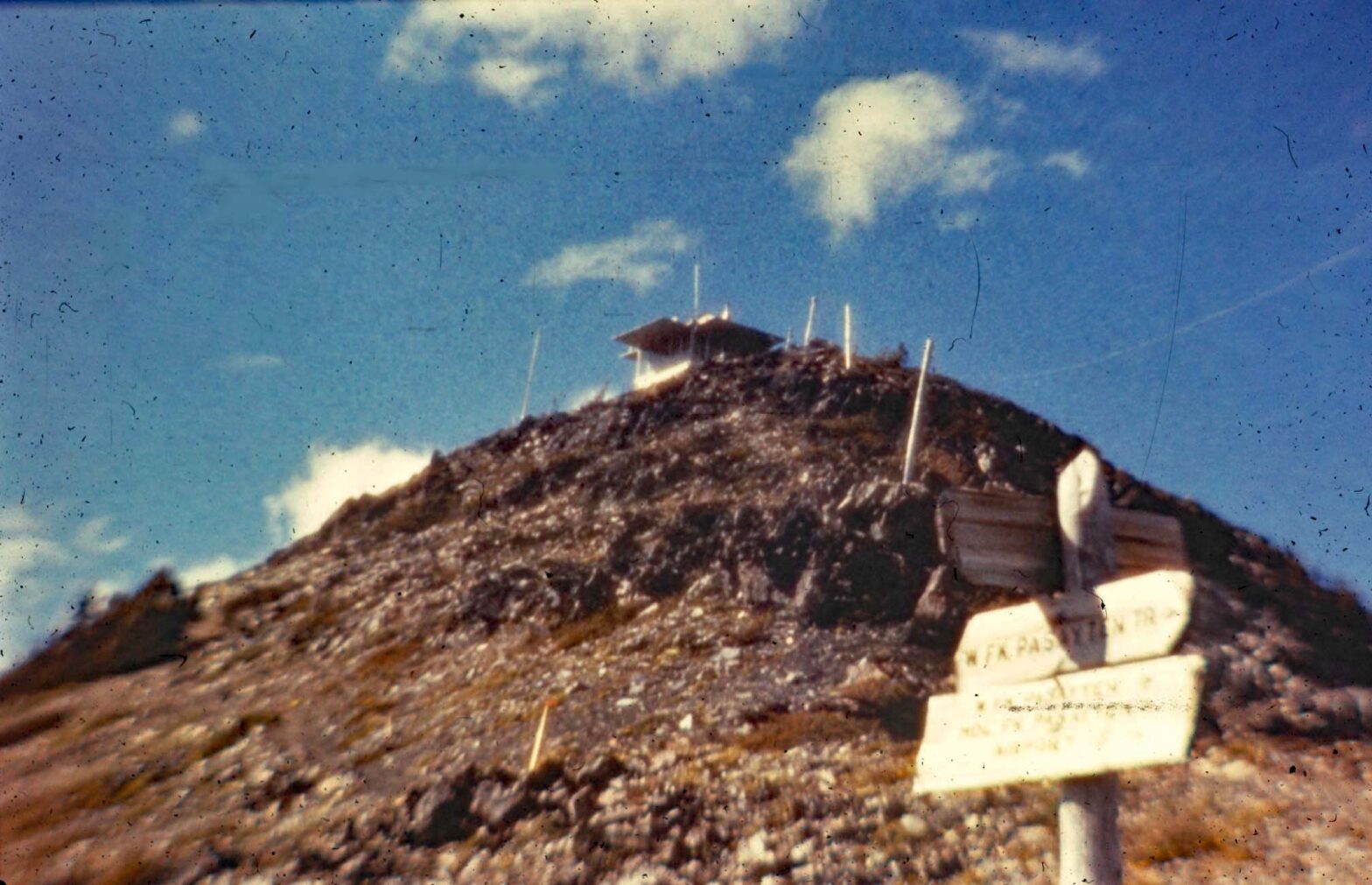REGIONS: ORIGIN SITE ~ North Central WA, RE-LO SITE ~ North Central WA

The move of an L-4 cab from Leecher Mountain to Slate Peak in 1954 is an interesting example of a Type 3 Lookout Re-Location. Both mountains have a long history of multiple fire lookouts. The combined history of the two includes three Lookout Re-Locations. When the Leecher Crow’s Nest is included, the two peaks have three “standing lookouts” that are on the SLOW93 list. The references that I have looked at contain differences in the history of both. These differences and uncertainties include the types and number of lookouts as well as variations in the dating. I asked some of the other lookout researchers questions about these differences. When Rex Kamstra replied with informative photos and information, he included an apt summary statement: “I’ve never been 100% sure we have the history of structures at these two sites cataloged correctly.”
After looking at quite a few sources and consulting with several seasoned lookout history researchers, I have put together a version of the probable combined history of lookouts on these two peaks. I want to emphasize the word probable as I had to often choose what I felt was most likely of several different inputs. There are still multiple “Mysteries” in the combined histories, including reported Lookouts and L-4 Cabs that may have, or may not have, existed. The following combined time-line summarizes my version of reality.
TIME-LINE SUMMARY
| YEAR | LEECHER MOUNTAIN | SLATE PEAK |
| 1918 | The 1st lookout was a crow’s nest tree located on a high point 1/4 mile from Leecher’s highest point. | ——— |
| 1922 | The 2nd lookout, a steel windmill tower with a 6′ x 6′ cab and a log cabin ground living quarters, was built near Leecher’s highest point. | ——– |
| 1924 | ———- | The 1st lookout, a gable-roof cabin with a cupola, was constructed. |
| 1925 | A bronze triangulation disk was set on the highest point of Leecher Mountain. | ——— |
| 1930s | A road was built to the lookout. | ——— |
| 1931 | The 2nd lookout, a gable-roof L-4 cabin was constructed. | |
| 1936 | A hip-roof L-4 was built to replace the log cabin as living quarters for the 2nd lookout. | ———– |
| 1942 | ——— | The 2nd lookout cabin was winterized and used by the Aircraft Warning System (AWS). |
| 1954 | o The 3rd lookout, a timber tower, was placed on Leecher Mtn’s highest point. o The tower was new while the L-4 live-in cab atop it had been moved here from Chiliwist Butte. o The 1936 L-4 living quarters cabin was moved to Slate Peak. o The 1922 steel windmill tower was moved to the North Cascades Smokejumpers Base. | The L-4 cab from Leecher Mtn was placed atop Slate Peak to become the 3rd Slate Peak Lookout. |
| 1956 | ———– | The US Air Force selected Slate Peak as the site for a Gap-Filler Radar. They took control of 119 acres atop the peak. |
| 1956-1960 | ———– | o The top 40′ of Slate Peak was removed along with the 3rd lookout to form the site for the radar station. o A road was built to the site and the radar complex was at least partially built. o The 4th Slate Peak Lookout, a 41′ timber tower, topped with a live-in L-4 cab, was placed on the radar site. |
| 1961 | ———– | o The radar was declared surplus and removed. o The control of Slate Peak was returned to the US Forest Service. |
| 2022 | o The 3rd lookout is still standing and is still being staffed. | o The 4th lookout is still standing and has been used on an emergency basis several times. |
A more detailed look at the lookout time-lines of these two sites, containing several unanswered questions and “mysteries”, follows.
Leecher Mountain
There have been 3 or 4 lookouts on Leecher Mountain. The last of these is still there and staffed, while the remains of the first is also still there. Both of these are on the SLOW93 Challenge list. The first, which dates from as early as 1918, was a crow’s nest tree on a high point about ¼ mile from the current Leecher Mtn LO.
The crow’s nest was replaced in 1922 by a steel windmill tower with a 6’ x 6’ metal cab. This lookout was apparently in service until it was replaced in 1954.
The following three articles are from the website washingtonlookouts.weebly:
August 28, 1921: “Contract awarded for lookouts–The Coast Culvert & Flume company of this city (Portland) has been awarded a contract to build two steel lookout tops for the forest service. One of these will be located on Leecher mountain, in the Chelan national forest, according to announcement at the district forester’s office.” (The Oregon Daily Journal)
June 1922: “Rangers Pierpont and Price are helping erect a lookout tower on Leecher Mountain. The tower is 40 feet high and of standard construction.” (Six Twenty-Six)
October 1922: “Our lookout accommodations have been greatly improved this season by the addition of a steel tower 50′ tall with a cage on Leecher Mountain.” (Six Twenty-Six)
A log cabin on the ground was built in 1922 to be the living quarters of this steel tower lookout.
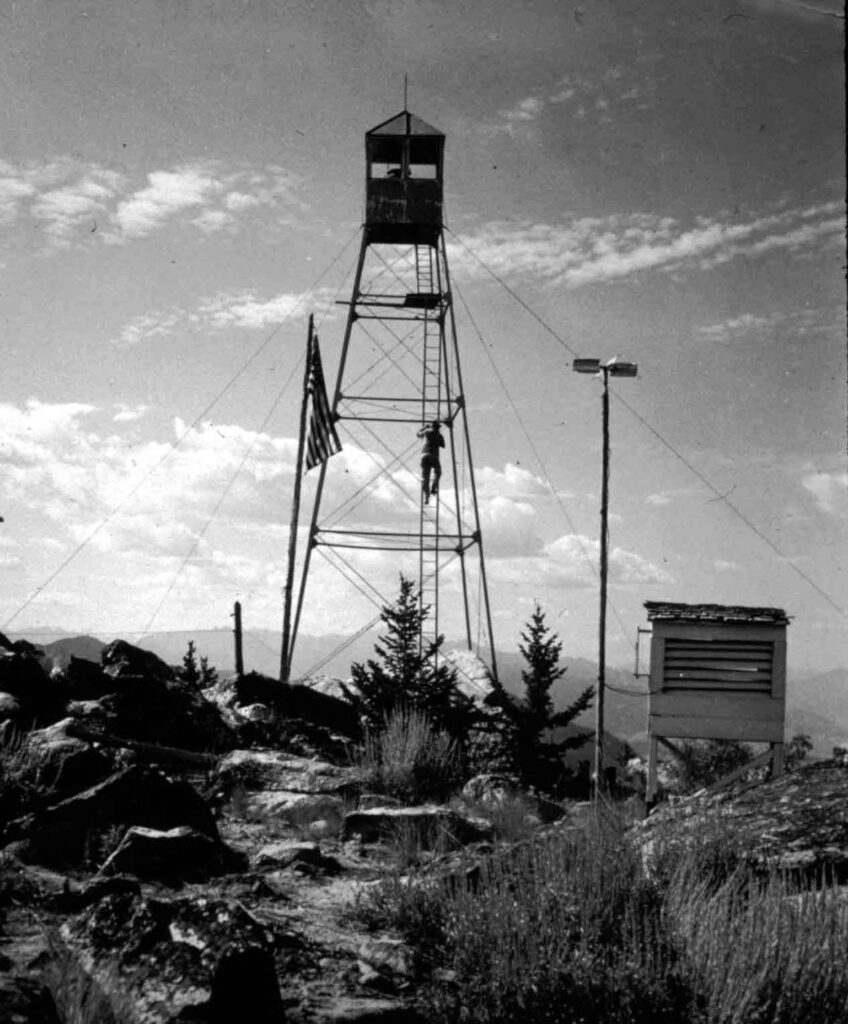
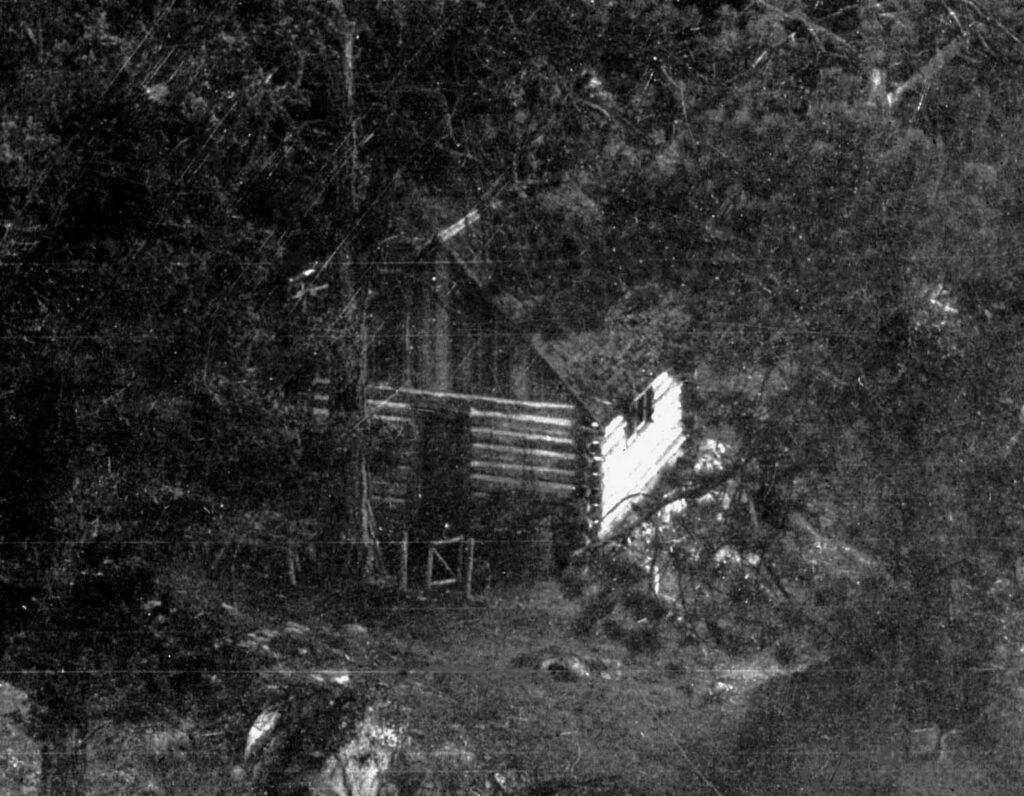
In 1925, a bronze triangulation disk was set “on the Highest Point of Leecher Mtn.” by the Coast Geodetic Survey (CGS). The NGS Data Sheet provides coordinates for this monument. In 1936, a hip-roof L-4 cab was built to replace the log cabin as the ground living quarters for the 1922 steel tower. The 1925 Station Description and Recovery Notes by later CGS and USGS parties in the NGS Data Sheet provides information that establishes the location of the 1922 steel tower and 1936 L-4 relative to the current Leecher Mountain Lookout.
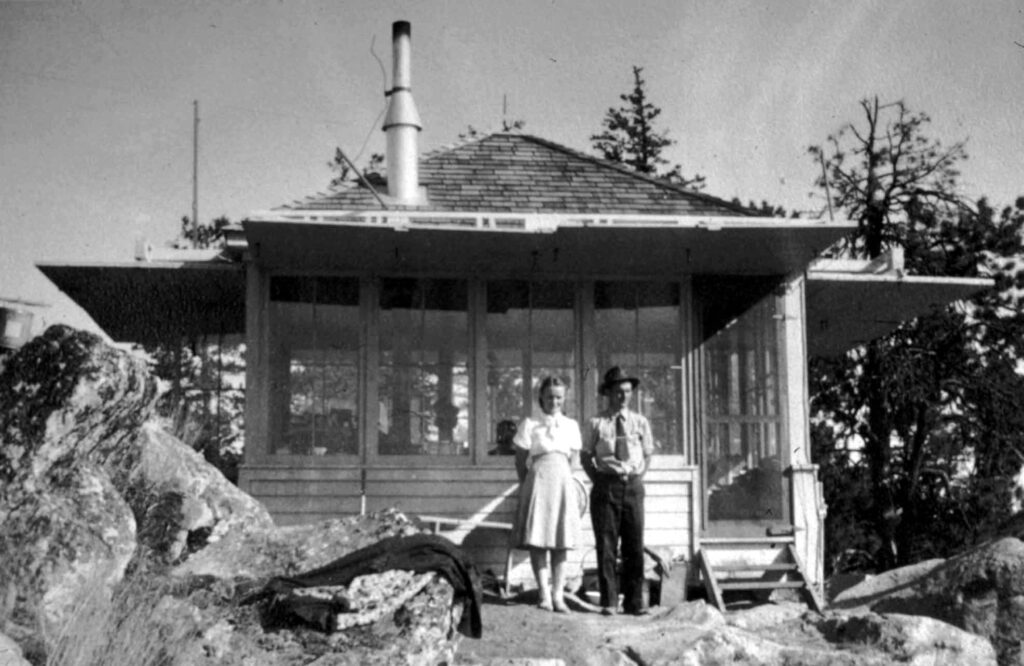

Several references report that another lookout, a timber tower with a live-in L-4 cab, was built on Leecher in 1941. There is some evidence that this “Mystery” Lookout with its “Mystery” L-4 did not exist. A 1950 CGS Station Recovery Note in the Leecher NGS Data Sheet reads in part: “The Leecher Lookout House is a standard wooden building, 14 feet square and sits on the ground……The Leecher Lookout Tower is a steel tower 50 feet high…..” Since the 1950 note does not mention any other buildings at that time, apparently the 1941 “Mystery” Lookout with its “Mystery L-4” was never built.
A 1953 letter to the U. S. Forest Service Supervisor in Chelan comments on plans to improve the Leecher Mountain Lookout by increasing the height of the existing 28 foot tower to reach 41’. The writer of the letter suggests replacing the current lookout with a standard treated timber tower and using the 28 foot tower at some other location. This letter introduces another “Mystery”. The “existing” steel windmill tower was described as 40, or 45 or 50 feet tall in different references. Where did this 28 foot tower come from? Rex provided a potential answer to this mystery when asked this question. Some people measure the height of a lookout to the base of the cab/catwalk and some quote the distance to the peak of the cab roof. This can lead to differences in quoted heights of more than 10 feet. (For example: In the Leecher NGS Data Sheet, a USGS 1956 Station Recovery report describes the current lookout as “a new 14×14-ft LOH on a 50-ft tower…..top of LOT is 55.2 ft, eaves are 49.2 ft, and floor is 41.0 ft above station mark.) Rex used the photo of the 50’ steel lookout which had a man climbing the tower ladder to estimate the tower’s height, to the bottom of the cab, as more like 30-32’.
The recommendation contained in the 1953 letter to build a standard 41’ treated timber tower and then to use the existing tower at some other location was followed. 1954 was a building and moving year on Leecher Mountain: 1) The third generation Leecher Mountain Lookout , a 41’ treated L-4 timber tower, was built in 1954. The L-4 cab was moved from the 2nd Chiliwist Butte Lookout and placed atop the newly built Leecher LO tower: 2) The 1922 steel windmill tower was moved to the North Cascades Smokejumper Base to be used in jump training ; 3) An L-4 cab, apparently the 1936 living quarters, was moved from Leecher Mountain to be used as the replacement lookout on Slate Peak.
Information contained in the Leecher NGS Data can be used to determine the relative locations of the 1922 steel tower, the 1936 living quarters L-4 and the current 1953 Leecher Lookout. The 1956 Station Recovery Note mentions that the steel lookout tower and its lookout house are no longer in existence and that the “new standard 14 x 14-ft LOH on a 50-Ft tower stands centered over the Station Mark”. Data contained in other Recovery Notes places the1922 steel tower 79 feet NW of the Station Mark and the 1936 L-4 living quarters 14 feet SW of the Station Mark. The relative locations can be visualized by comparing the two photos shown below. The historic photo shows the 1922 steel tower and the 1936 L-4 living quarters. The photo of the existing Leecher Mountain Lookout was taken in 2015 at a similar location and looking in a similar direction. The big rock in the left foreground appears in both photos. The rock formation by the corner of the L-4 also seems to be in the 2015 photo.

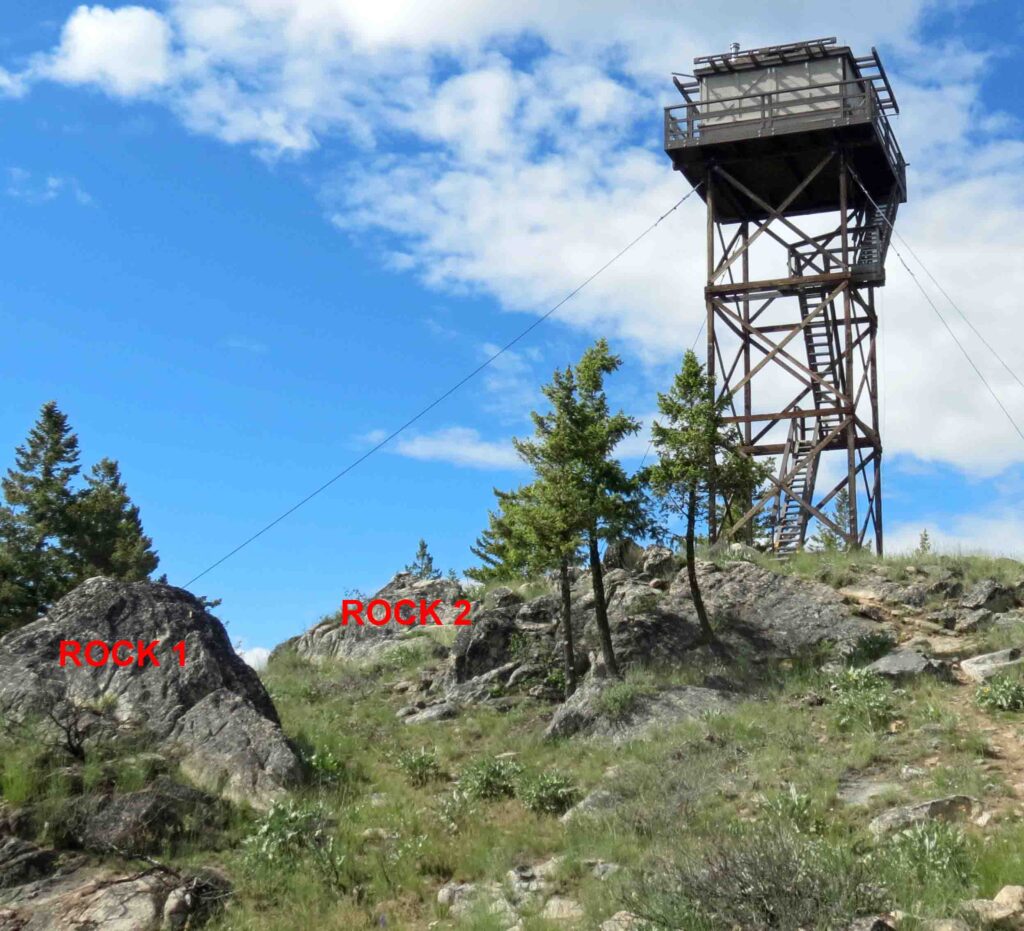
Slate Peak
The lookout history on Slate Peak is as complicated and mystery filled as that of Leecher Mountain. There have been three or four lookouts on Slate Peak. The first Slate Peak Lookout was a gable roof cupola cabin built in 1924. Very little is known of this “Mystery” lookout and apparently there are no existing photos of it. Most references list it. An entry from the website washingtonlookouts.weebly only reads “1924: A gable-roof cabin with a cupola was constructed”.
Another lookout building was constructed in 1931. Most references do not mention this one, but photos exist and Ron Kemnow’s website washintonlookouts.weebly contains the following articles:
September 3, 1931: “Ed Allen and Raymond Johnson left Tuesday for the mountains where they will complete the work on the lookout house at Slate Peak.” (The Wenatchee Daily World)
September 1931: “Slate Peak, a lookout-fireman’s point on the Chelan near Harts Pass, was occupied for the first time this year. We immediately took advantage of this occupancy and strung some eight miles of emergency wire to connect with this point. A couple weeks ago, said lookout reported a fire on Upper Slate Creek; it probably would have got to some size before our nearest lookout might have picked it up. As it was, we had a man to it in a short time — result: a class A fire.
Thanks, Chelan — hope we may return the help some day. L.B. Pagter” (Six Twenty-Six)
These articles do not describe the type of lookout structure constructed in 1931, but two photos from the Okananogan National Forest archives show a gable-roof L-4 sitting on the ground atop Slate Peak.
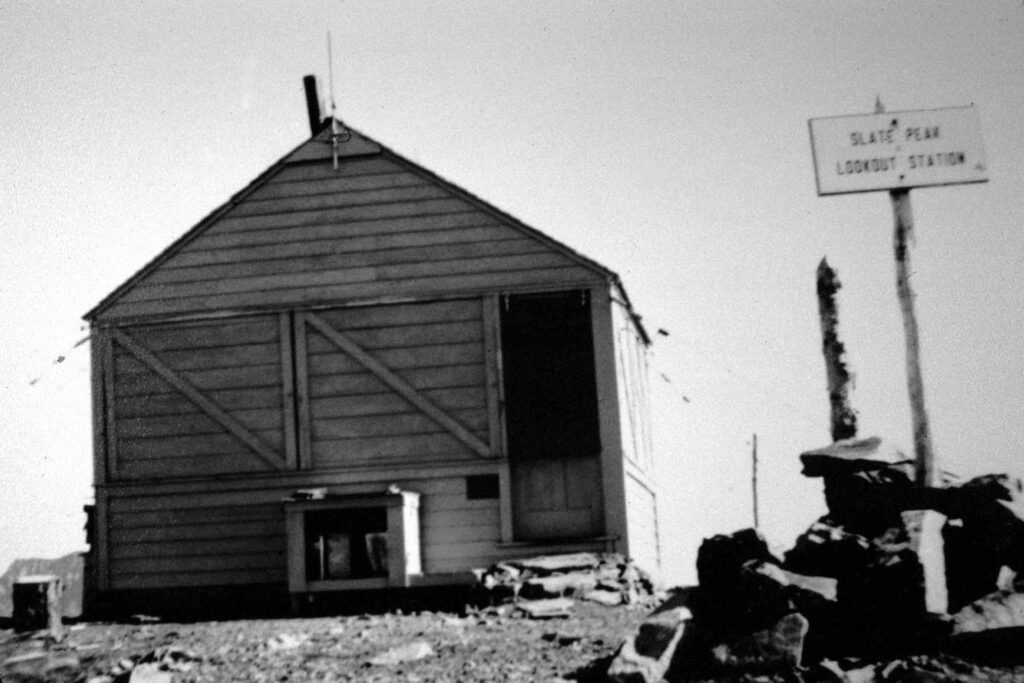


One interpretation of the sentence reading ” Slate Peak, a lookout-fireman’s point on the Chelan near Harts Pass, was occupied for the first time this year” in the article above leaves the existence of the 1924 “Mystery” lookout in question.
The 1931 lookout was then replaced in 1954 with the hip-roof L-4 cab from Leecher Mountain. Two years later, the lookout fell victim, at least temporarily, to air defense concerns which arose during the Korean War. The US Air Force selected Slate Peak to be a gap-filler radar site. Approval had been given in 1950 for the construction of the second segment of the US Air Defense Command’s permanent radar network. Twenty-eight manned Surveillance Radar Stations were built, including the Colville Air Force Station. The Colville Station had five un-manned gap-filler stations, including Mazama atop Slate Peak, attached to it. The gap-filler radars were designed to detect low flying aircraft which might not be detected by the longer range radars of the manned network. The typical gap-filler radar installation consisted of a radar tower and an L-shaped auxiliary building.


The USAF took over control of the top of Slate Peak. They removed the top 40 feet of Slate Peak and the L-4 cab Slate Peak Fire Lookout in order to create a flat area atop the mountain that was large enough to hold the radar tower and associated buildings. The date of the removal of the top of the mountain has been often reported as 1956, but it may have happened in late 1957. A photo exists, with a caption reading 1957, which shows what appears to be the hip-roof L-4 on the original Slate Peak Mountain top.

The USAF then built an access road, a control building, two underground fuel storage tanks, a radar tower and a latrine. At some point during the 1956 -1960 radar construction time period, an L-4 Fire Lookout was built on the new top of Slate Peak. The pre-radar site lookouts had been placed on the ground. The new lookout required a 41 foot tower to allow seeing over the edge of the larger lowered mountain top. This placed the new lookout’s live-in L-4 cab at the same altitude as the earlier lookouts which had sat on the ground atop the original mountain top. Several photos exist showing both the radar tower and the 41’ fire lookout tower at the same time atop Slate Peak.
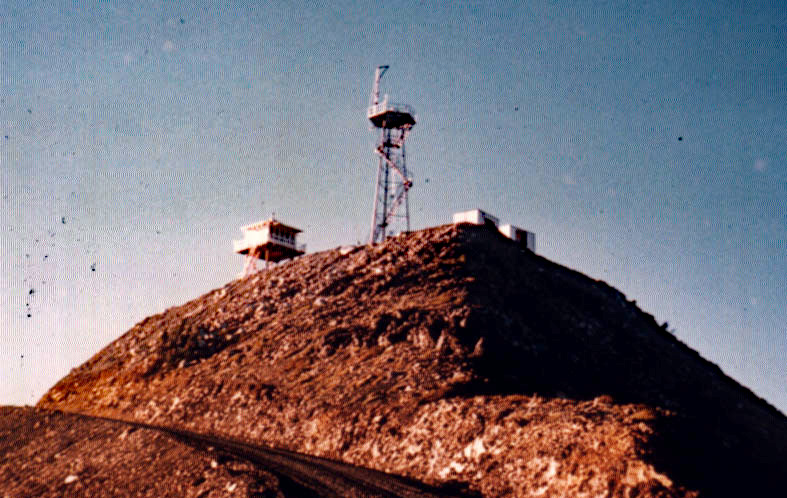
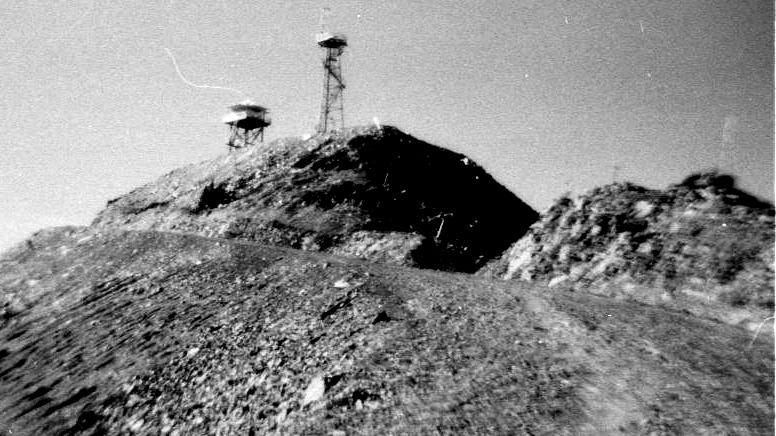
Different references disagree as to whether the construction of Mazama gap-radar was ever completed and whether it was ever used. One reference states that the Mazama site was at least partially constructed but was never operational. Another report states that the site was constructed in 1960 and that after less than one year of operation, on January 4, 1961 it was declared surplus. All salvageable material was removed, leaving only the concrete slab for the control building and the latrine. The 41 foot L-4 lookout tower was left atop Slate Peak along with the L-shaped concrete slab. Control of the top of Slate Peak was returned to the US Forest Service. The Lookout is still there and has been staffed several times on an emergency basis.
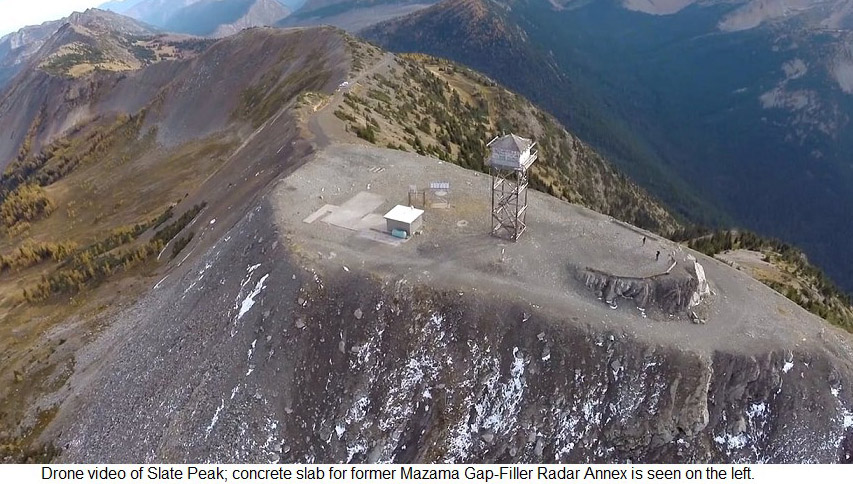
One “Mystery” remains. When the USAF removed the top 40 feet of Slate Peak, they also removed the L-4 lookout cabin that had been moved to Slate Peak in 1954. Was this L-4 destroyed at that time or was it saved to be used several years later as the live-in cab atop the current 41′ timber tower? If the hip-roof L-4 cab seen in the photos of the current Slate Peak Lookout is the one built in 1936 to serve as the living quarters for the Leecher Mountain steel windmill tower, then it is nearly 70 years old.
Leecher Mountain L-4 Ground Cabin Moved to Slate Peak



Our visit to Slate Peak, the RE-LO Site for the 2nd Leecher Mtn LO’s L-4 Ground Cab
We drove to Slate Peak, which at 7400 feet is the highest point by road in Washington, on July 7, 2001. We hoped to show a hiking friend who was visiting us from England views of some of the Pasayten Wilderness and North Cascades Peaks. We could see the lookout atop the flattened peak above us as we neared the end of the road. We had a short road walk as a closed gate blocked the road near the top.
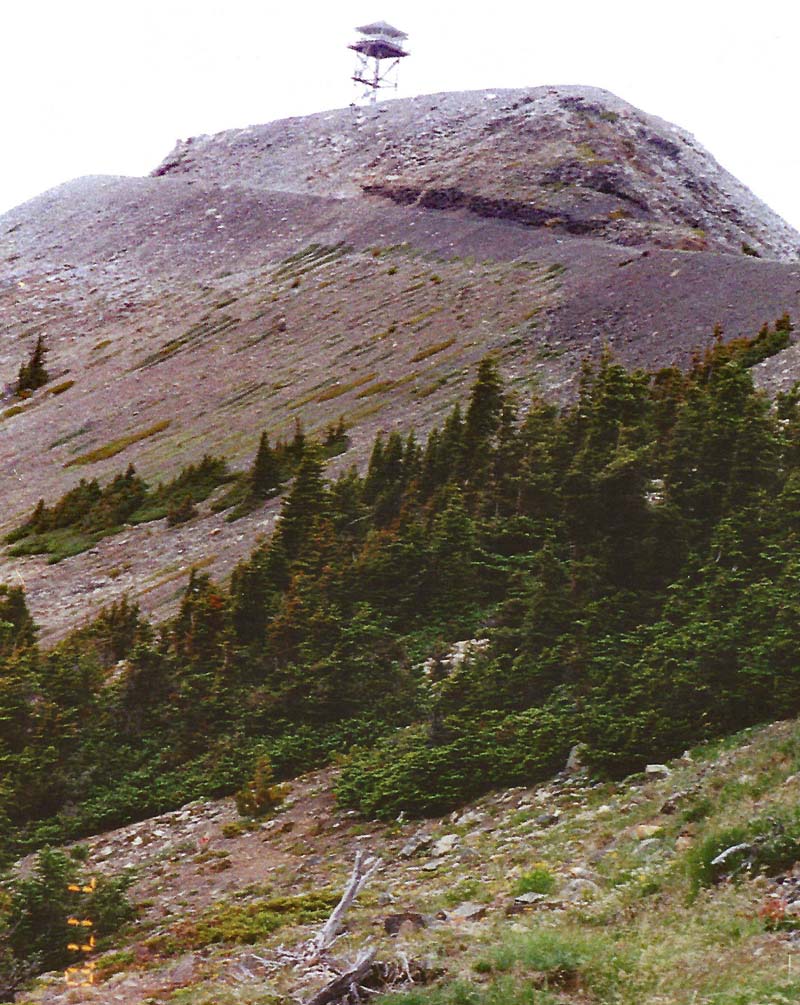
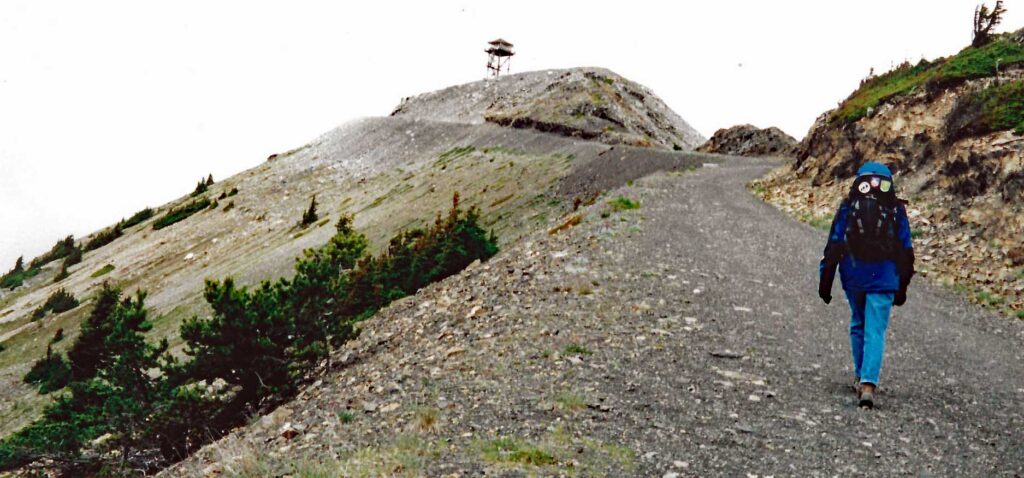
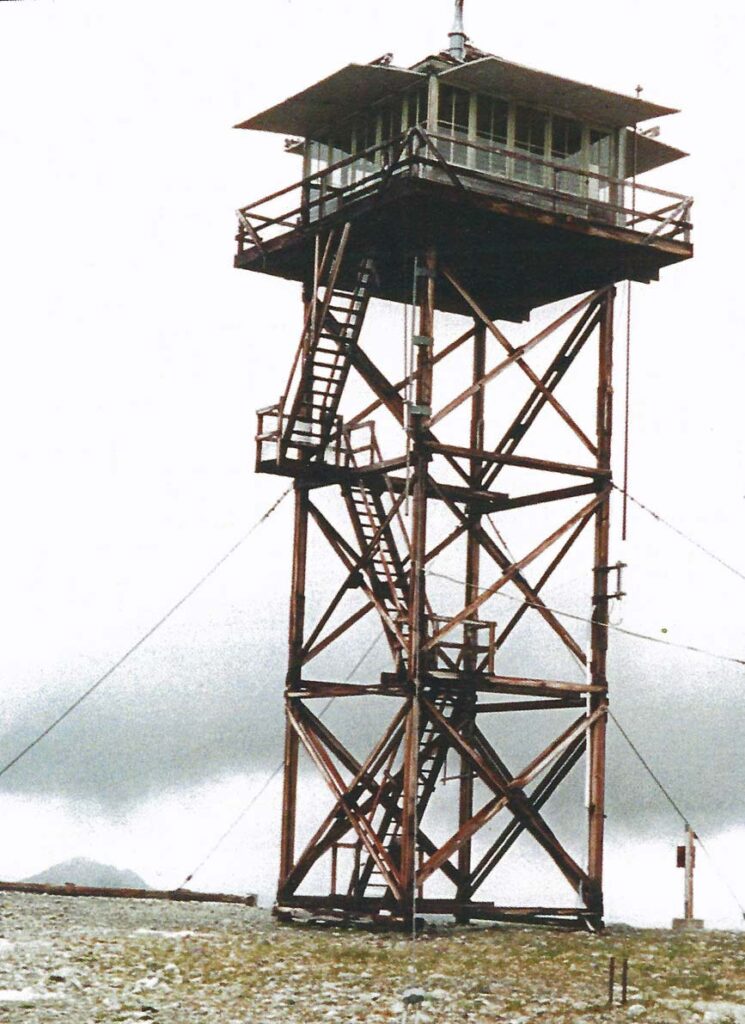
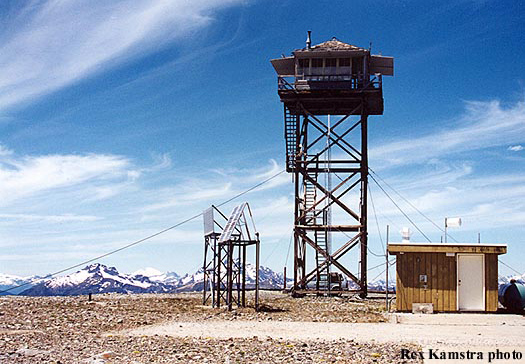
Slate Peak is on the southern border of the Pasayten Wilderness, with big mountain views in all directions. Low lying clouds blocked some of views of the surrounding mountains on the day that we visited. Several photos borrowed from a Wikipedia article show some of the clear day views that we missed.


Slate Peak is less than 20 miles from the Canadian border. The lookouts and AWS personnel staffing the station there sometimes faced severe weather conditions due to Slate Peak’s height and northern location. Wenatchee Daily World articles in Ron Kemnow’s web site washingtonlookouts.weebly.com reported four feet of snow remaining on August 19 in 1932 and 1 foot remaining on September 18 in 1934. In addition, the 1932 article reported a snow storm in early August along with alternating cold nights and hot days.
Slate Peak was also a target for lightning. Another article describes one of the lightning strikes:
August 27, 1932: “Ray Paul, lookout stationed on Slate Peak in the northern part of the Chelan National forest, arrived home from a long trip yesterday… {He was} just in time to be an unwilling host to a stray lightning bolt, which came in, apparently, to seek shelter from the storm…. {The lightning bolt shattered} the wire cage designed to protect the new lookout stations from such visitations…..{The} bolt damaged the roof, played havoc with the telephone and set Paul’s bed afire. The forester extinguished the blaze with a bucket of water but was unable to rescue a $15 Pendleton blanket. The Slate Peak station is of a type {which is as} nearly lightning proof as can be obtained, according to H. F. Brundage, assistant regional forester in charge of forest protection. The walls are almost entirely of glass, surrounded by a wire cage designed to intercept lightning.” (The Wenatchee Daily World)
Eric Willhite reports in his web site that the 1st Slate Peak lookout was also hit by lightning which set the lookout on fire and melted a keg of nails.
Our visits to Leecher Mountain, the ORIGIN SITE for the Slate Peak 3rd Lookout
Our first visit to Leecher Mountain was on June 4, 2015. We drove through burned over areas, evidence of the 2014 Carleton Complex fire. Heavy downpours had helped douse the fire in August, 2014, but they had also caused mudslides. The lookout access road had been badly damaged by these mudslides in several places. We were able to drive to a closed gate located 1.2 miles from the lookout. We walked the road from the gate through a mix of live and fire-killed trees. The lookout was not being manned. The shutters were down and the access to the catwalk was locked.

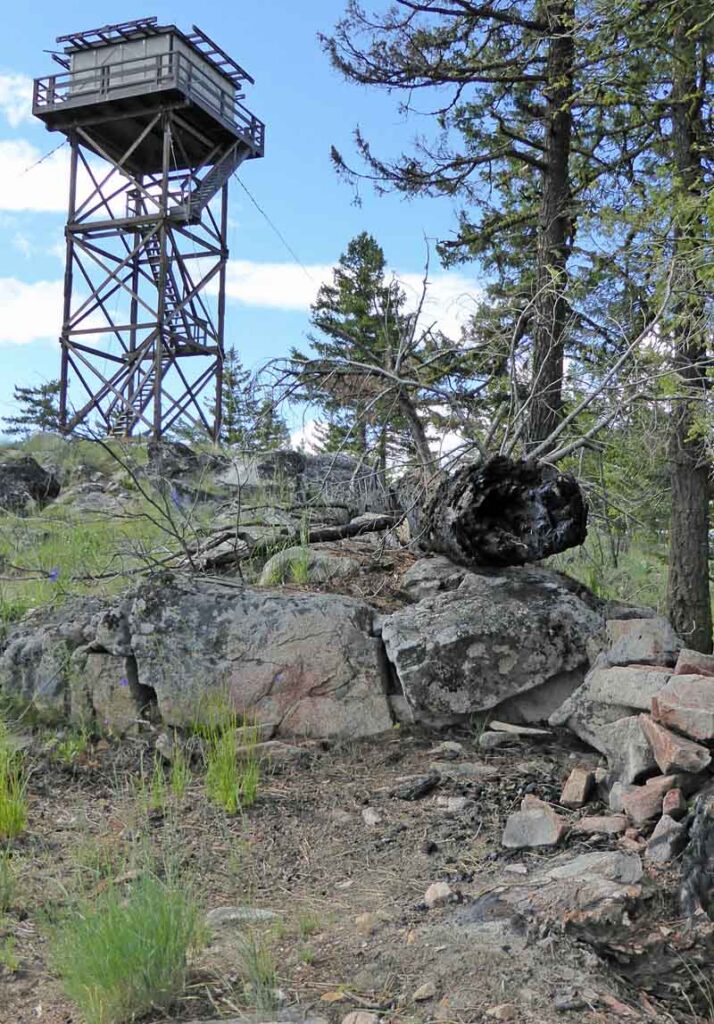
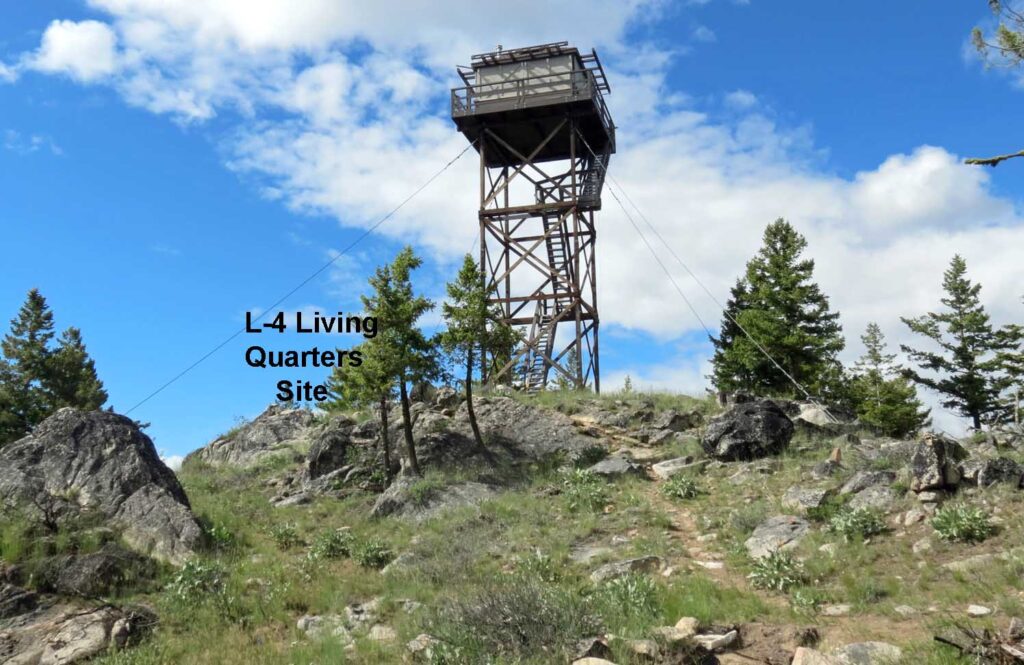
An article in the July-August, 2014 Washington Trails magazine read in part:
“ Lightning Bill” Moves From Goat Peak to Leecher Lookout
Those longing to catch a glimpse of U. S. Forest Service lookout legend “Lightning Bill” Austin will find him in a new spot this year. After a 19-year tenure at Goat Peak in Mazama, Austin has been reassigned to the Leecher Mountain Lookout southeast of Twisp. The move comes amid a shrinking Forest Service budget and shifting firefighting resources……..As of mid-June, Austin has settled into the Leecher Mountain Lookout and is ready for visitors.”
Then lightning started four wildfires in the Methow River Valley on July 14, 2014. They soon merged to form the huge Carleton Complex Fire which eventually burned over 256,000 acres. When the Carleton fire spread and threatened the Leecher Mountain Lookout, Lightning Bill was forced to leave Leecher and was moved back to Goat Peak.
From washingtonlookouts.weebley.com: “July 17,2014: The lookout was evacuated by helicopter….{F}lames from the Carleton Complex Fire had effectively surrounded the lookout making escape unsure at a later time. The lookout was not re-staffed as a primary lookout this season.”
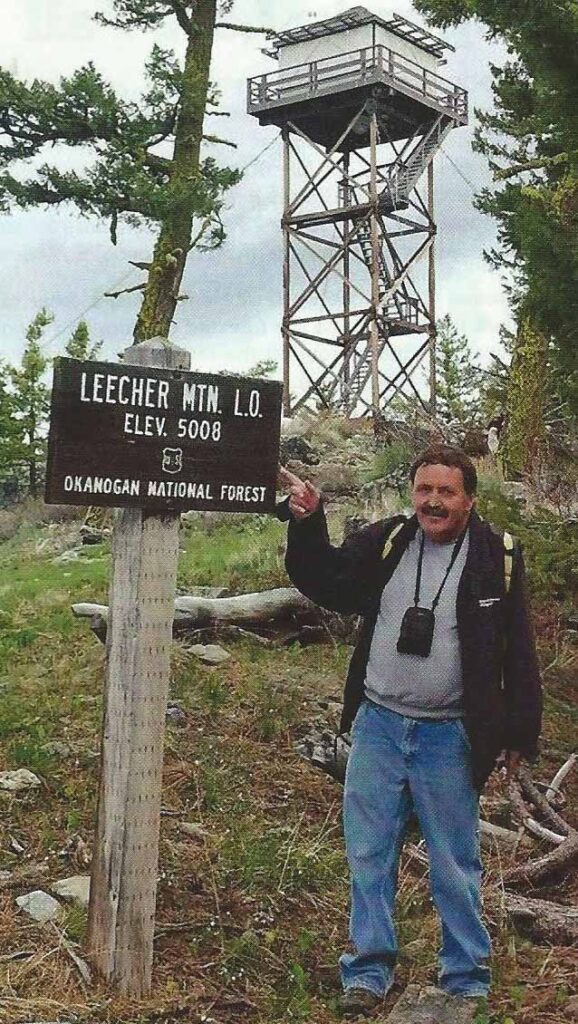

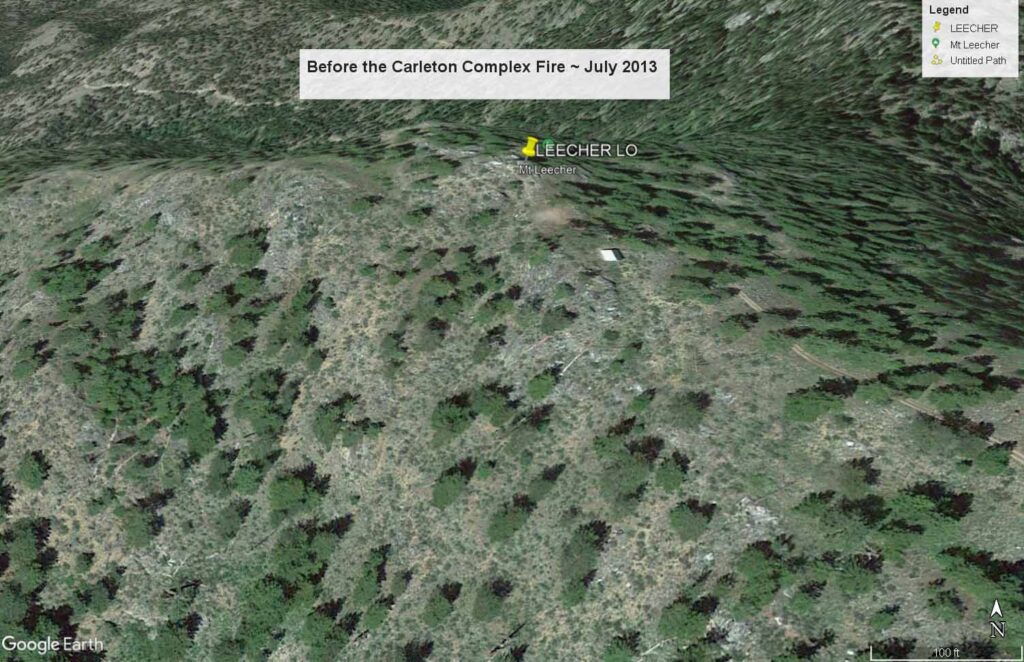

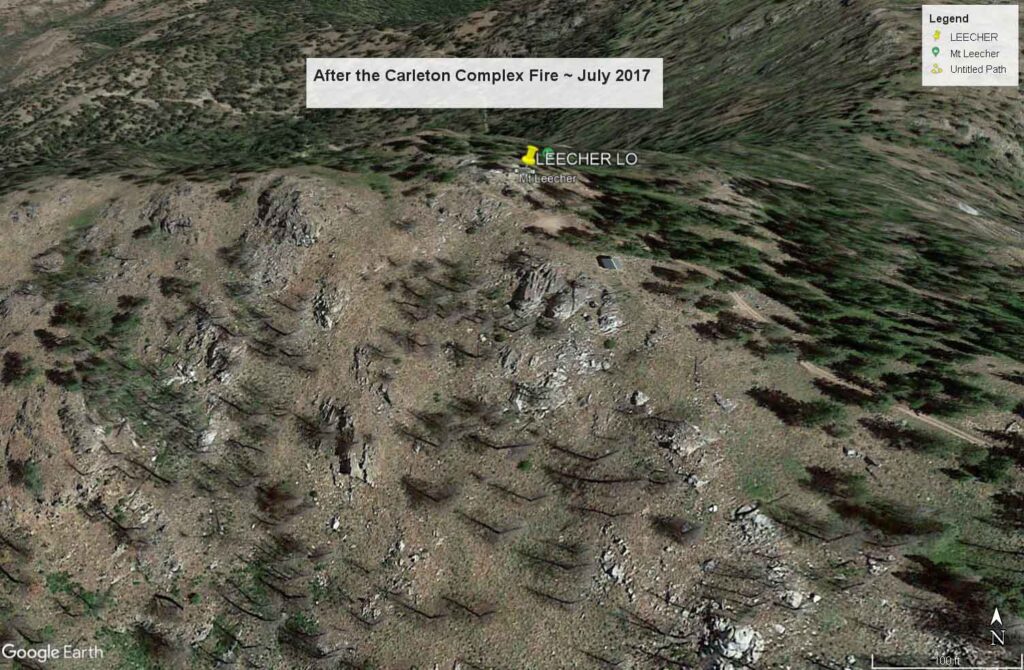
We re-visited Leecher Mountain on September 9, 2017. We stopped to visit the Leecher Crow’s Nest, its 1st lookout, on the way.

